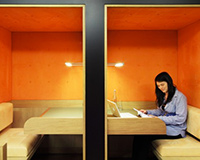 There is a considerable ROI in putting your staff’s health and wellbeing at the forefront of building decisions.
There is a considerable ROI in putting your staff’s health and wellbeing at the forefront of building decisions.
Owing to huge leaps in technology we are all working longer hours and the boundaries between work and other aspects of life are blurring.
There is a growing demand for workplaces that are more comfortable and pleasant to be in and which encourage greater productivity from their occupants. The future for office refurbishments is to provide sustainable space with a greater emphasis on health, wellbeing and happiness.
For landlords and developers, this provides an opportunity to find buildings with unique selling points that meet this demand. For tenants, it is a chance to attract and retain the very best talent, and maximise the productivity of their workforce.
While landlords are looking for the next big thing so they can achieve the best rents, many tenants are looking to stand out by providing environments for their staff that are better than those of their competitors. Does the building have cycle racks and shower facilities, a roof terrace, very good natural light, high ceilings, contemporary finishes, good-quality local amenities?
This is now being taken one step further by US real estate company Delos, which believes that wellness in the workplace is the future of the built environment.
Delos is the creator of the WELL Building Standard, which has been introduced in the US to ensure that the construction and design of buildings are focused on nurturing human health and well-being.
The standard is a culmination of seven years of research by leading scientists, doctors and architects and sets performance requirements in seven categories relevant to occupant health in the built environment – air, water, nourishment, light, fitness, comfort and mind.
Staff in one of the pilot WELL Certified office schemes say it has had a positive impact on their productivity and performance, with 83% saying they feel more productive and 94% claiming the new space has had a positive impact on their business performance.
For both landlords refurbishing their buildings and tenants fitting out their offices, there is a cost balance. However, for landlords taking this new way of thinking into account when developing or refurbishing their buildings, it could well be a very profitable move.
For tenants, providing good-quality space for staff rather than looking for value space in a dark basement may prove more profitable for their business.
With the introduction of benchmarks like the WELL Building Standard and the boom in start-ups, co-working and fresh thinking, the built environment needs to evolve.
As our work-life balance becomes of greater importance, how we feel at work and how we perform is key to moving future business forward. Wellness is the obvious next step.
Barney Lewis is an associate in Allsop’s West End business team and specialises in office development and leasing, working with both landlords and tenants
Case study: Blackstone
Natural light is key to a healthy office. Tenants do not want lower ground space despite it offering value for money. It does not offer value in the long term.
Allsop recently advised Blackstone on the refurbishment and subsequent letting of two office buildings on the High Holborn Estate in Midtown, WC2. Both buildings were drab, dark office properties and were not performing to their maximum potential.
Working with architects BuckleyGrayYeoman, they were transformed from old corporate-style office space to modern, light-filled offices repositioned to take advantage of the growing demand for office space in Midtown.
The two buildings were stripped back and “defurbished” with polished concrete, parquet floors and LED lighting. Both had corporate-style suspended ceilings, which were taken out to maximise ceiling height and natural light. New exposed air-conditioning units were installed and where possible the original features were retained.
The basement was transformed into a large area for bike racks and shower facilities, and a communal roof terrace was created so tenants could interact with each other socially. As a result, both buildings were let very quickly and achieved some of the highest recorded rents in Midtown.
The tenants came from many different sectors, showing that space that is attractive, pleasant and offers staff something extra is becoming a priority.










